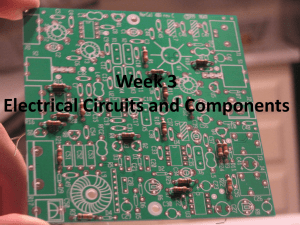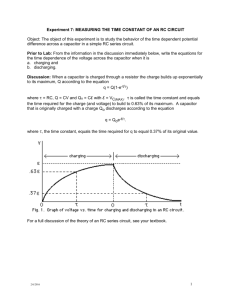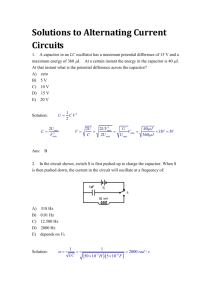experiments_1_11_15
advertisement
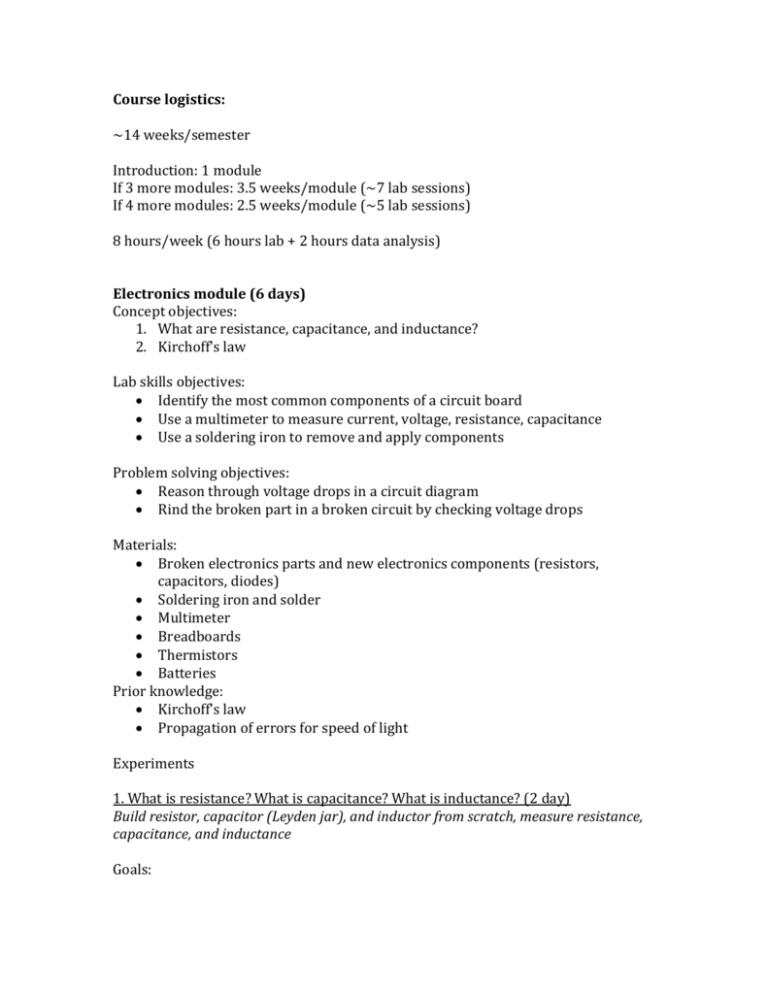
Course logistics: ~14 weeks/semester Introduction: 1 module If 3 more modules: 3.5 weeks/module (~7 lab sessions) If 4 more modules: 2.5 weeks/module (~5 lab sessions) 8 hours/week (6 hours lab + 2 hours data analysis) Electronics module (6 days) Concept objectives: 1. What are resistance, capacitance, and inductance? 2. Kirchoff's law Lab skills objectives: Identify the most common components of a circuit board Use a multimeter to measure current, voltage, resistance, capacitance Use a soldering iron to remove and apply components Problem solving objectives: Reason through voltage drops in a circuit diagram Rind the broken part in a broken circuit by checking voltage drops Materials: Broken electronics parts and new electronics components (resistors, capacitors, diodes) Soldering iron and solder Multimeter Breadboards Thermistors Batteries Prior knowledge: Kirchoff's law Propagation of errors for speed of light Experiments 1. What is resistance? What is capacitance? What is inductance? (2 day) Build resistor, capacitor (Leyden jar), and inductor from scratch, measure resistance, capacitance, and inductance Goals: 1. Make a resistor from paper + graphite. Measure "resistance" using a multimeter. Explore different lengths and widths of pencil marks on this quantity called "resistance". Experimentally determine the relation of length and width to the "resistance" to understand what resistance is. 2. Make a capacitor from salt water, and insulator (water bottle), and a conductor (aluminum foil). Measure this quantity called "capacitance" by bringing a metal object close to the aluminum foil and measuring the maximum distance that a spark occurs at. How does "capacitance" depend on the saltiness of the water and the area of the aluminum foil? 3. Build an inductor from scratch using a coil. Measure the value of a quantity called "inductance". Need to think of an educational way to do this. 2. Make circuits: light bulb, RC, and LC (2 days) 1. Make a circuit with a battery and light bulb. Learn how to use a multimeter to measure voltage, current, and resistance. Change the lightbulb to an LED. Measure V, I, R again: what do you observe. Now change the LED to different resistors. Experimentally find a relation between V, I, R. Now, try putting 2 resistors together. What happens if join just one of the ends? Both of the ends? Try to find a quantitative law for both of these situations, so you can always predict the current and resistance that you measure. 2. Make a circuit with a resistor and capacitor in 2 different ways: in series and parallel. Apply an alternating current to each configuration and measure the voltage before and after the resistor + capacitor. Do you observe a lag? How does this lag change when you change the values of the resistor and capacitor? 3. Now make a circuit with a capacitor and inductor in 2 different ways: in series and parallel. Again apply an alternating current and observe. 3. Soldering tutorial (1 day) 1. Learn how to safely use a soldering iron to make a simple circuit. 2. Learn how to desolder parts of an existing circuit board + SMA circuit board 4. Make RC filters for speaker system (1 day) 5. Radio (+ antenna) (2 days) 1. Day 1: Build 2. Day 2: Debug + make antenna Different kinds of radios: 3-penny, etc. 6. Arduinos? Arduino temperature controller https://8.13.scripts.mit.edu:444/wiki/index.php/Arduino_Temperature_Controller 7. Measure the speed of light with a giant capacitor and giant inductor Equipment to be made ahead of time, or as independent project: 1. Printed circuit boards from inkjet printer http://electrons.psychogenic.com/modules/arms/art/10/PrintedCircuitBoardPCB HOWTOAnIllustratedGuide.php http://www.robotroom.com/PCB.html 2. Oscilloscope Arduinoscope: https://code.google.com/p/arduinoscope/ Audio in/out: http://homediyelectronics.com/projects/howtomakeafreesoundcardpcoscilloscope /?p=1 Software: http://www.zeitnitz.eu/scope_en Energy module (3 days) 1. Radiation law with incandescent light bulb (3 days) Day 1: Apply different voltages, and measure current vs. resistance. Day 2-3: Measure the temperature by using existing resistance vs. temperature curve for Tungsten. Determine effect of temperature of power radiated. Determine the Stefan-Boltzmann constant by breaking apart light bulb and measuring the filament surface area. In what temperature regions can we neglect convection? Resources: 1. http://iopscience.iop.org/0031-9120/10/1/005/pdf/00319120_10_1_005.pdf 2. http://scitation.aip.org/docserver/fulltext/aapt/journal/ajp/36/9/1.19751 65.pdf?expires=1424018068&id=id&accname=2106337&checksum=79B65 E4DCA94CDEA4D4330F363B8A2C8 3. http://scitation.aip.org/docserver/fulltext/aapt/journal/ajp/46/4/1.11299. pdf?expires=1424018086&id=id&accname=2106337&checksum=5DCA81B8 18A2258CA329DB031E5E641A 2. Make solar cell from beet juice (2 days) Light and Optics (3 days) 1. Use flashlight and lenses to determine relationship between parameter that characterizes lens (focus), object distance, and image distance. Can you think of an easy way to measure the focal length of the lens? (1 day) 2. Young's double slit interference experiment with coherent sunlight through a pinhole. What does this tell us about light as a particle? As a wave? Can you experimentally determine a relation that tells you where to expect bright spots and dark spots? (1 day) 3. Learn about polarization. Experiment with multiple sunglasses lenses oriented at different angles in front of a light source. What do you notice? What property of light can you deduce? (1 day) 4. Measure the speed of light with a Michelson interferometer Possible Independent Project Ideas: Disassemble DVD drive to make laser Make bike-powered cell phone (or other device) charger o Can be used to make batteries or other electricity for other uses Calculate where to place sound-absorbing boards in high-echo classrooms Create mass spectrometer or device for UV-VIS spectroscopy. Extension of any of the ideas we learned about: making a new electric circuit or building a solar powered x. More big data oriented projects: e.g. survey of water level at different locations in Kigali Fiber optics
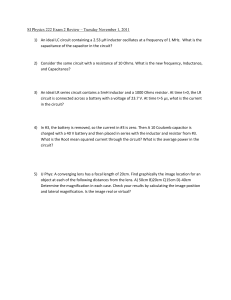

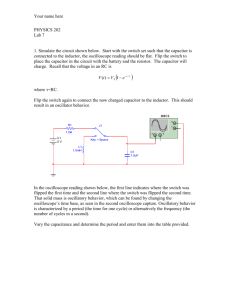
![Sample_hold[1]](http://s2.studylib.net/store/data/005360237_1-66a09447be9ffd6ace4f3f67c2fef5c7-300x300.png)



